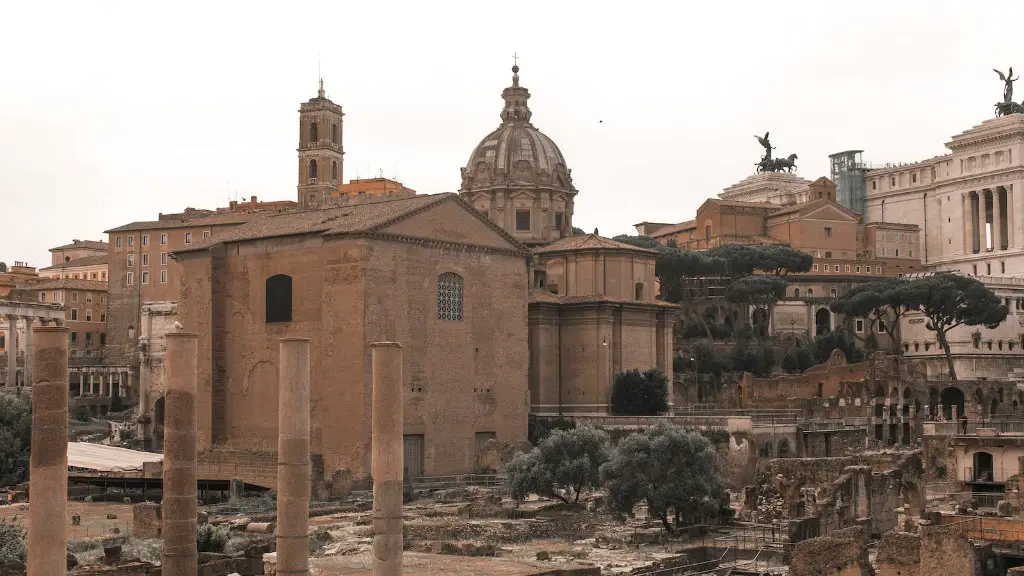At its peak, the Roman Empire was one of the largest empires in the world. Covering most of Europe, North Africa, and the Middle East, it was home to over 50 million people. Today, Rome is a shadow of its former self. But how much of ancient Rome remains?
The answer may surprise you. Although the Roman Empire fell over 1,500 years ago, many of its buildings and other structures are still standing. In fact, some of the most iconic buildings in the world, such as the Colosseum and the Pantheon, are from ancient Rome.
Of course, not all of Rome has survived the centuries. Much of the city has been destroyed by wars, natural disasters, and the effects of time. But thanks to the work of archaeologists and historians, we still have a pretty good idea of what ancient Rome looked like.
There is a great deal of ancient Rome that remains. Much of the city’s infrastructure is still in place, including roads, walls, and sewers. Many of the ancient buildings are still standing, including the Colosseum and the Pantheon. In short, much of ancient Rome is still very much in evidence today.
How much of ancient Rome still exists?
It is estimated that only 10 percent of ancient Rome has been excavated. The remaining 90 percent is buried 30 feet or so below the current street level. This is an incredible amount of history that has yet to be discovered.
The Roman Empire was one of the most powerful empires of its time. It lasted from 27 BCE to 476 CE, but the remnants of the once great empire still remain in the form of architecture. Although the empire is now in ruins, the architecture is still visible and is a reminder of the empire’s former glory.
Why is so much of ancient Rome buried
As Rome grew and changed over time, various parts of the city became buried under new construction. This process began in classical times, when Roman architects would often tear the roofs off of old buildings and fill their interiors with dirt in order to create solid foundations for new structures. Over time, this led to the gradual disappearance of Ancient Rome, as it became increasingly buried under new development.
There are a number of possible explanations for this decline in population. One is that the Roman Empire was simply too large to be sustainably populated, and that as it expanded, its population became more and more dispersed. Another possibility is that the Empire was plagued by disease and that, as its population grew, so did the incidence of disease. Additionally, it is possible that Roman society was simply not conducive to large families, as it placed a high value on personal achievement and individualism. Whatever the reasons, the decline in population had profound consequences for the Roman Empire, as it made it more difficult to defend against barbarian invasions and to maintain its vast territory.
How tall were Romans 2000 years ago?
The average life expectancy for a man in Ancient Rome was around 40 years. However, the average height was shorter than today’s Romans, at around 5’5”. Despite these shorter lifespans and heights, the Ancient Romans were a force to be reckoned with!
The fall of Rome was a turning point in history, marking the end of the Roman Empire and the beginning of the Middle Ages. The East continued as the Byzantine Empire, while the West fell into chaos. The German chieftain Odoacer deposed the last Roman emperor of the West, Romulus Augustulus, in 476, completing the fall of Rome.
Who was the last Roman alive?
Julius Nepos was the last de jure Western Roman Emperor, ruling from 474 to 480. Nepos was ousted by Odoacer, who became the first de facto ruler of Italy. Nepos fled to Dalmatia, where he was assassinated in 480.
The Roman, Viking, and Norman rulers of Britain did not leave their genetic calling cards in the DNA of today’s mainland Caucasian population.
What is the furthest Roman ruin from Rome
The Farasan Islands are thought to have been attached to the province of Arabia Felix at some point in history. If this is correct, it would make the Farasan Islands the farthest Roman outpost, being nearly 4000 km from Rome itself. This is an interesting piece of history and it would be interesting to learn more about it.
The catacombs of Rome are no longer a visible burial site. The bodies that were once buried there have either been moved to other sites or have disintegrated over time. While the catacombs are now mostly empty, they still hold an important place in the history of the city.
How far underground is ancient Rome?
The past few centuries of excavations have uncovered that certain parts of Ancient Rome are up to 7 to 11 meters below the current ground level. This is according to the research of Burghignoli and Callisto in 2013. This is an interesting discovery that can give us insight into the history and development of Ancient Rome.
The texts don’t give a clear answer as to why this was the case, but it’s possible that it had to do with the availability of burial sites or the wishes of the families of the deceased. In any case, it’s clear that the crucified were not simply left to rot on the cross, but were given some level of care and respect.
What was the Roman average life expectancy
Longevity has increased steadily through history. Life expectancy at birth was a brief 25 years during the Roman Empire, it reached 33 years by the Middle Ages and raised up to 55 years in the early 1900s. Today, life expectancy in developed countries is over 80 years. This increase in life expectancy is due to improved living conditions, advances in medicine and public health measures.
The city of ancient Rome was one of the most populous cities in the world during its time. With a population of roughly 450,000 inhabitants, it was comparable to other pre-industrial and modern urban centres in terms of size and density. The city was home to a large number of people from all walks of life, including many of the most wealthy and influential citizens of the Roman Empire.
What percentage of Rome’s population was enslaved?
The slave population in the Roman empire during the period 260–425 AD is estimated at just under five million, representing 10–15% of the total population of 50–60 million inhabitants.
In order to join the Roman legion, soldiers had to be in good physical condition. They had to be able to march 20 miles in 5 hours while wearing full armor and carrying a 45-pound kit.
Who was the tallest Roman
Maximinus Thrax was a Roman Emperor who ruled from 235 to 238. He was born in Thracia and died in Aquileia, Italy. He was married to Caecilia Paulina. He was a rival of Gordian I and II.
The chart above shows the average height of males and females in various world countries. As can be seen, there is a significant difference between the average heights of males and females in most countries. In Italy, for example, the average male height is 1765 cm (5ft 9 1/2in), while the average female height is 1625 cm (5ft 4in). This difference is even more pronounced in other countries, such as the United States, where the average male height is 1772 cm (5ft 10in) and the average female height is 1678 cm (5ft 6in).
Warp Up
While much of ancient Rome is in ruins, some amazing archaeological sites remain. The Colosseum, for example, is one of the most iconic ancient Roman structures that is still standing today. Other well-known ruins include the Forum, the Baths of Caracalla, and the Palatine Hill.
There is a great deal of ancient Rome that remains today. Much of it is in ruins, but there are also many well-preserved buildings, monuments, and artworks. Rome was a very large and influential city in its time, and its legacy can still be seen in many ways.





